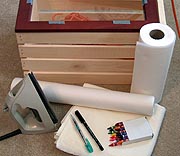Many of our patterns, especially the smaller designs, can be used in crayon quilts. No appliqué or piecing is required. You can even color in the borders. Crayon quilts are easy family and classroom projects and a great way to get your children involved.
Design suggestions:
A is for Alphabet
Farm Fresh Faces
Friendship Bears
Bearly a Month
Sports Bears
The Garden
Dinosaurs
Little Choo Choo
Peace on Earth
Nativity
Pocketful of Posies
and other small designs. Just remember to use white or off-white fabric for the background.
MATERIALS NEEDED:

- Fabric (100% cotton, white or off-white)
- Crayons (Crayola® or Prang® are recommended; DO NOT use washable crayons)
- Freezer paper
- Mechanical pencil
- Fine point black fabric pen or marker
- Light box
- Iron and ironing board
- Paper towels
PREPARE THE DESIGN:

- Use a hot dry iron to press the freezer paper on the back of the fabric. Cut the fabric to the desired size.
- Using the light box and a mechanical pencil, trace the design onto the right side of the fabric.
- Draw over the pencil lines with the fabric marker or pen.
COLOR THE DESIGN:
- Leave the freezer paper in place while coloring.
- Color the design as desired.
SET THE COLOR & REMOVE THE WAX:
- Remove the freezer paper from the fabric.
- Place the fabric between sheets of paper towels.
- Iron (at “cotton” setting) the fabric. Lift the top paper towels. Replace and repeat until no more color or wax is removed.
- More color can be added if a darker shade is desired. Be sure to repeat this step.
SEND US A PHOTO OF YOUR CRAYON QUILT:
- If you have used one of our patterns in a crayon quilt, we’d love to see it.
- Your photo will be featured in our online Gallery. Our email address can be found on our Contact Us page.
SUGGESTIONS:
- The width of the marking pen is a matter of taste. We used fine and ultra-fine markers and pens. Make sure the marker or pen is intended for use on fabrics and is permanent ink. Always test on a scrap.
- Don’t worry about drawing “perfect” lines when tracing. The hand drawn look adds character.
- Lettering (for example, a name or saying) can be added. Trace the letters on the paper design before tracing it on the fabric. Check out possible fonts and sizes on your word processing program. Print out the letters for tracing.
- If you do not have lightbox, a brightly lit window will work in a pinch. Plus you’ll provide entertainment for the neighbors.
- Add texture to your coloring. Find household materials to place behind the fabric (remove the freezer paper for this step). Try window screen, coarse sandpaper, plastic canvas, wall texturing, tree bark, even the cheese grater.
- Shading can be achieved by pressing firmly for darker areas, less firmly for lighter areas.
- Crayon quilts can be washed in cold water. We recommend that you color a sample square and wash it multiple times to determine how well it will retain the color. You may prefer to limit this technique to wall quilts.